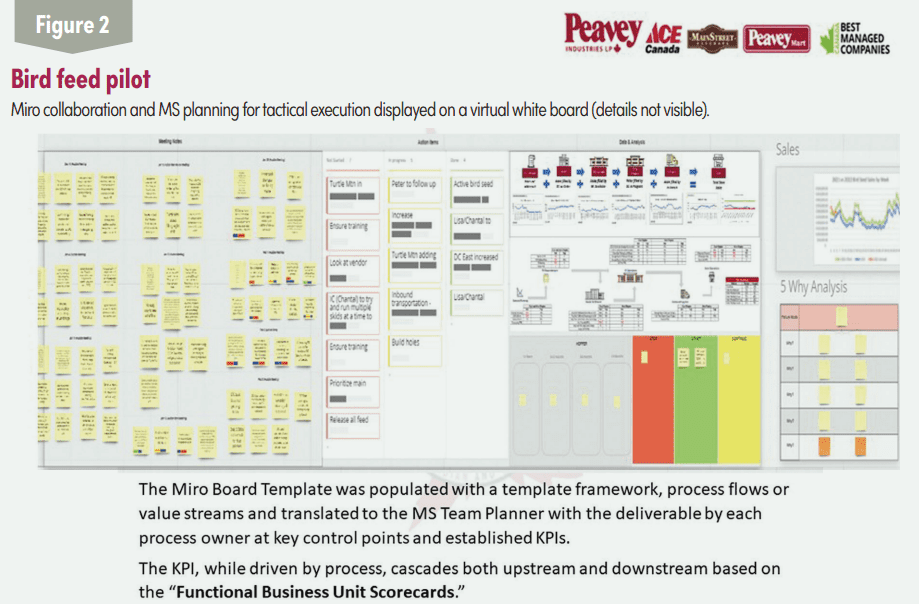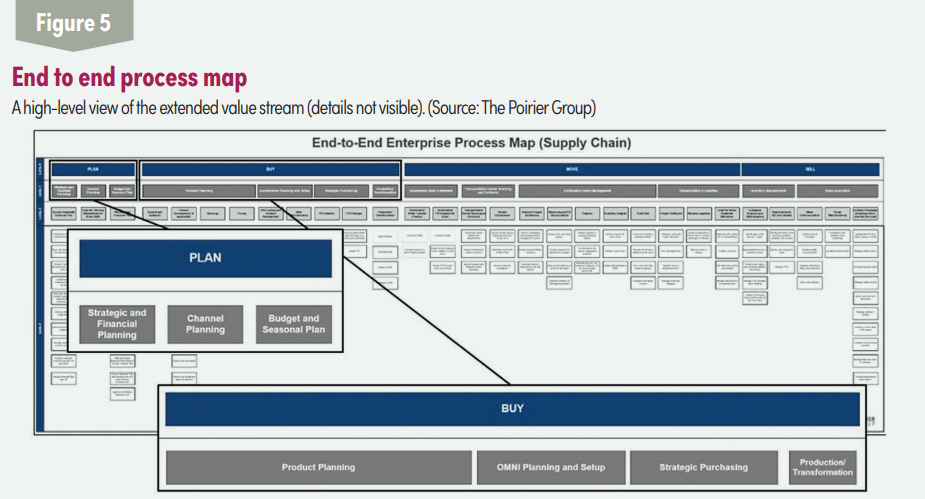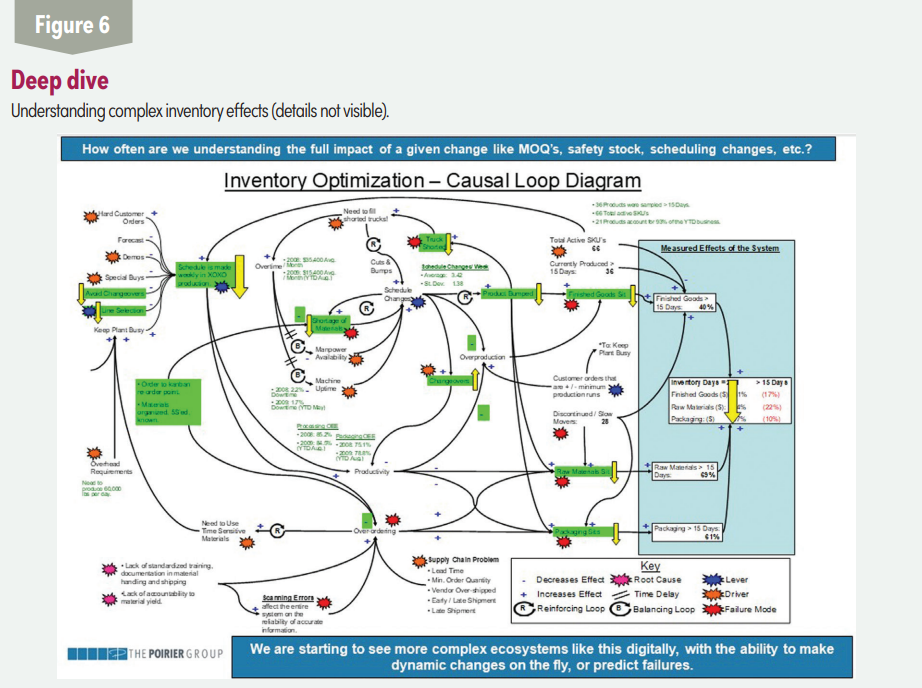Webinars focus on need for insightful leadership, innovation in change era
By D. Scott Sink and Jared Frederici with contributions from Jim Tompkins and Peter Hunter
Our December article focused on how to create resilience in operations excellence in the decade ahead. It was a capstone to a three-part miniseries of webinars focusing on how to execute business process improvement better and faster and in doing so create resilience in the face of a steady stream of disruptions. Jim Tompkins, David Poirier and Jim Dobson were featured contributors in those webinars; Jim shared highlights from his recently published book, Insightful Leadership: Surfing the Waves to Organizational Excellence. In January-February, we zoomed in from organizational excellence to supply chain management (SCM). Once again, Jim Tompkins led off another three-part miniseries with some great insights. We followed that with a case study from Peavey Industries and Peter Hunter shared some innovative cross-functional SCM-focused improvement work along with results achieved. And we capstoned our SCM trilogy with Jared Frederici sharing examples of innovative integrated systems engineering examples for supply chains, end2end-wise. This article provides a quick summary from those latest webinars in our IISE Global Performance Excellence Professional Development series.
Supply Chain Leadership Insights for the 2020s
from Jim Tompkins’ webinar Jan. 6, 2023
David Poirier shared his six critical factors for success for what will surely be a challenging 2023 in his webinar Dec. 13, 2022:
- Develop/invest in your talent; you win with people.
- Create value – diversify and solidify existing revenue streams and continue to invest in positioning and marketing to prepare for growth post economic downturn.
- Control costs – reduce wastes aggressively, improve productivity and quality.
- Reduce working capital, improve liquidity by making tough, timely choices but also by finding ways to manage assets.
- Build/grow your business process improvement capabilities.
- Improve flow – reduce cycle times and lead time, focus on cross-functional value stream improvement.


Jim really zeroed in on almost all of these factors in his webinar. First, he noted that “success” for supply chains has evolved over the past 20 years. The requirements for success have migrated from a focus on efficiency to effectiveness to recovering trust to resilience and “optionality.” It is an “and” not an “or” type of equation. Supply chains have to be effective, efficient, productive and ensure quality at every step. It’s the right things, in the right place, in the right amount, at the right “quality” at the right cost all the time. Second, he challenged us to think about the fact that the future is not an extension of the past. There is no getting back to normal. We will have to learn to live with “known uncertainty.” The roles of the CEO and the chief supply chain officer (CSCO) have changed forever relative to supply chain management. The greatest opportunity for ISEs and supply chain professionals is to drive effective and rapid innovation and drive business process improvement faster and better.
Third, he prompted us to think about the nature of improvement. Think about continuous improvement, DMAIC (define, measure, analyze, improve, control) projects, DCDOV (define, concept design, detailed design, optimize, verify), design for Lean Six Sigma, reengineering projects and then transformational initiatives or even reinventions. In the face of the “new normal” being disruption, his point is that continuous improvement alone isn’t enough. A balanced portfolio of projects is required to address the challenges that VUCA (volatility, uncertainty, complexity and ambiguity) create. The new goal isn’t just to be competitive; it is to leap ahead of the competition.
Finally, Jim walked us through the role and shifting impact that technology, demographics, employment/employees, circular economy, globalization and digital supply networks (e.g., SCM 4.0 and 5.0) have in supply chain management strategy and execution evolution. We encourage you to take advantage of the on-demand library of webinars to hear Jim speak to these contextual factors. Jim shared what we all sense, that 2023 and the “Roaring ’20s” will be very challenging. A premium will be placed on being able to tap into insightful leadership (data, information, knowledge, understanding, skill and wisdom) and make the right strategic choices. Perhaps more importantly, we make countless tactical and operational choices every day that have strategic consequences. Making sure insightful leadership is leveraged when those are made is super critical to success in times filled with VUCA.
Best In Class Case Studies: Cross Functional Process Excellence at Peavey Industries
Peter Hunter, Peavey Industries, Best Practice Case Study
We intentionally went from Jim’s high level, strategic insights presentation to a best practice example of how supply chain management is being tackled and successfully improved. We invited Peter Hunter, director of training/development and organizational change at Peavey Industries, to share a very successful initiative with our members and customers of IISE Jan. 13.
Peavey was in the process of doubling its retail footprint in the Canadian market as a result of a recent acquisition/merger. This was putting pressures on many support functions, perhaps most pronounced was the supply chain. The short version of the need/problem is that there were many stock-keeping units (SKUs) and categories in the stores that had in-stock problems. There were many other issues but in-stock (holes) was the one this case focuses on. We worked with Peter and others at Peavey to create a migration strategy that would address business system and process improvements required to ensure that the new retail stores could be accommodated, and that Peavey was positioned for additional growth and performance improvement for the strategic horizon. Peter shared how they successfully integrated the following “solution elements” and have continued to deploy this approach organizationwide:
1. Cross-functional, end2end, extended supply chain value stream mapping.
- Creating simple, easy-to-understand extended value stream maps highlighting critical alignment points, control points, key roles and responsibilities, key performance indicators, etc.
- Got alignment on where the control point problems, pain points were and addressed them.
2. Created a value stream core team with representatives from every ‘control point’ in the value stream from vendors to
stores.
- Introduced a tiered huddle system.
- Integrated Miro (visible collaboration software) with PowerBI/Sharepoint to improve visibility for the cross-functional value stream improvement team.
3. Visible measurement and management systems.
- The centerpiece of the “huddle board” is the scorecard/dashboard (Figure 1, Page 27). Learning to measure what matters takes some work but the right measures can provoke the right decision/actions/adjustments and, ultimately, improvement.
- PowerBI is utilized to slice and dice the data and create visualizations that create insights.
- Sharepoint is utilized to create visibility to all the team members in the cross-functional value stream and also within slices of the value stream.


One of the hardest elements and factors for success in supply chains is getting people across the value stream to communicate and coordinate to create visibility for what’s happening to the flow of “value” from front to back. In a factory, we’ve created cells but that isn’t physically possible with all systems. In sequentially interdependent facilities with long lines, we’ve installed two-second Lean along with value stream walks and gembas. But in supply chains, you cut across organizations, across functions (silos) and span geographies and time zones. As such, ensuring that all the partners and process owners across these extended enterprise value streams are working in an integrated fashion to meet the requirements of flow is challenging. Fortunately we have great technology available and a rapidly growing understanding and maturity at managing virtually. We explored the concept of tiered huddles in our Aug. 2, 2022, webinar “Tiered Huddle System Detailed Case Study–Emory Healthcare” featuring Victoria Jordan, Emory Healthcare’s vice president, quality.
In a hospital, you can do physical huddles. Visibility/huddle boards are installed in hallways to promote even more visibility. In supply chains with substantial amounts of transactional processes, we utilize virtual huddle boards; Peavey used an app called Miro, which essentially was a virtual white board (Figure 2). It and other apps like it have many features and functionalities that make it a useful component in a visible management system. The hard part is learning how to design what you put in the whiteboard space and how you manage periodic huddles with the huddle board as the centerpiece. As Peter mentioned in the webinar, picking and training the right facilitators for huddles, regardless of whether they are virtual or physical, is a critical factor for success. The proof is in the pudding, as they say. In Peavey’s first pilot (large bird seed/feed category, over 100 SKUs), they were able to drive in-stock from 69% to in excess of 92% and stabilize process capability in just five months. In their pilot of huddles and visible measurement/management systems within their distribution centers (DCs), they were able to improve productivity (lines picked per hour) by 20% in one facility and by 100% in another. This has come about as a result of the engagement, communication and coordination, cross-functionally with the DCs and, as Jim Tompkins mentioned, a push for more rapid innovation with technology enablement and process/methods improvement. The bottom line for us relative to this second webinar in our miniseries is this: Most organizations have improvement activities in their supply chains and specifically in their DCs.
What makes this case example different is the context for the work in the DCs, the concurrent system focus, end2end, cross-functional approach to work at any of the control points in the supply chain. The DCs, as an example, understood their critical role in flow for the supply chain better as a result of tackling category in-stock improvement end2end. We experienced more focused and innovative process improvement taking place and more intentionality because results
were measured at all the control points in the supply chain, made visible and the end-game, in-stock was crystal clear as were causal relationships to the drivers for in-stock. In short, this case study that Peter Hunter shared is a great example of the application of insightful leadership to drive extraordinary improvements in the Peavey supply chain. Next, we’ll provide an executive summary for our third, capstone webinar in our supply chain management 2023 series.


Supply Chain Management 4.0 in Periods of Disruption
Jared Frederici, MBB, The Poirier Group
The third and final webinar in our SCM 2023 miniseries focused on having Jared Frederici share examples of how ISE principles, methods and tools are used front end to back end in supply chain value streams. While there are certainly a number of different types of supply chain systems, what they have in common is that they move things, fulfill customer orders and are a part of the order fulfillment business process in organizations. One of the early key points Jared shared was the importance of taking a systems view and doing an assessment of supply chain maturity. In the example he shared, note that he includes the extended supply chain view, not just the physical flow of goods or services. The capability maturity model integration (CMMI) type of scale (process maturity level) can be utilized with 1 being low maturity and 5 being optimal maturity. As we did with Peavey, the end2end supply value chain is mapped with control points identified (Figure 3).
A control point is a spot in a value stream where we can and should measure performance and also where we can make decisions and take actions that will improve flow and other aspects of performance in the supply chain. An example of a next step in the supply chain business process improvement work is to understand what is possible, performance wise, for the supply chain and/or for some component of the system. Jared shared the chart in Figure 4 (Page 30) depicting
a benchmarking study we did for an e-commerce furniture supply organization. We took them from a state of data rich/information poor to information rich and supporting important choices in one month. The chart is plotting DC total costs as a percent of sales for the organization in stages that represent periods where the supply chain system was constant, with no major interventions made to how the DCs operated.
The chart at the right of the figure depicts benchmarks that were obtained overlayed with annual budgets and then also an ISE-engineered forecast of what we felt was possible. Note they had been running as high as 15%, and the engineered standard, benchmarks and what is possible were down around 4.5%. Going through this type of analytics lays the foundation for a shared vision for system performance. Getting alignment to that is critical and very doable. We actually went through a similar process with Peavey in its bird seed/feed pilot and that shared vision relative to performance targets played a key role in what was achieved. The final snippets from Jared’s webinar involve how ISEs can utilize hierarchical functional flow mapping and also systems dynamics modeling. A Level 1, high level view of the extended value stream is a great place to start; see Figure 5 (Page 31). Once the potential performance capabilities have been identified and the performance potential (with benchmarking) has been completed, we typically do a more detailed mapping of the end-to-end enterprise level process map for supply chain. The point is that we’re mapping out workflows, left to right, front to back of the supply chain. This map often is done in Visio, which allows for layering or annotation and for zooming in to lower levels of detail; for example, for plan and buy, as shown.
Jared walked us through it, left to right, and provided some examples of innovative ISE tool application at each stage or slice of the supply chain value stream. Visio provides the ability to layer in (or out) various icons representing characteristics of each control point –pain points, failure modes, waste (by type), critical alignment points and key performance indicators (link to charts), etc. This process breakdown structured approach creates a systematic way to ensure you are tackling the right projects and have an optimal portfolio in your business performance improvement program. It also provides what is required to do a value stream walk across the enterprise functions through the current/future state value stream map. This is a great way to get all the process owners to understand interdependencies; roles, responsibilities, accountabilities and authorities (R2A2); and to get alignment on areas needing improvement.
The last tool we’ll highlight is use of what’s called systems dynamics modelling (SDM), often a precursor step for simulation.
In Figure 6, though the specifics aren’t fully visible, is the concept we want to convey. Within any supply chain system supplier, there are complex interdependencies and interrelationships between factors and variables that drive whether we have the right things, in the right place at the right time in the right amounts at the right quality. Modeling these factors as shown helps understand system dynamics. When we do this, optionality is invoked, and we can ensure insightful leadership. When we don’t do this, we are forced to manage performance armed only with opinions and often flawed beliefs in cause-and-effect relationships. When the leadership team in this food processing plant and warehouse saw this model and then started to play around with “what ifs” and understood the balancing and reinforcing causal loops, it was an “aha” moment and light bulbs clicked on. They could identify counterintuitive options that had to be applied to get the equation right. The entire team got aligned more quickly on what to do, collectively, to drive working capital (inventory) down to the right levels to sustain flow but also to improve profitability.
A new way of thinking
The supply chain business process, function, system has become a focal point for most people as we have dealt with the multitude of challenges that the latest disruption created.
Key points from the three webinars are as follows:
- Understand that supply chain management will never be the same; the context and the requirements for success have changed irrevocably.
- Learn how to take advantage of insightful leadership (profound knowledge, via W. Edwards Deming).
- Tackle supply chain performance cross-functionally.
- Engage people with the new models for high performance teaming to improve value streams and end2end.
- Understand your supply chains’ maturity.
- Create an end-to-end view of your supply chain.
- Systematically identify and make the right interventions leveraging the right tools.
a) Understand full potential performance.
b) Silver bullet technologies aren’t common; pragmatic options exist.
c) The weakest links in the chain often are just getting the basics right.
d) Get great at building business cases, realistic portfolio planning, migration strategies and BPI execution.
e) Build better demand volatility, disruption impact models and deploy as part of your ongoing SCM plan-do-study-adjust
process.
D. Scott Sink is a past president of IISE and currently a member of the Council on Industrial and Systems Engineering. He served as vice president of business process improvement for two firms in Toronto, Canada, from 1997-2007. Before that, he was a professor at Oklahoma State University and Virginia Tech. From 2007-2020, he led the Integrated Lean Sigma Certification Program in ISE at The Ohio State University. He currently is a senior adviser with the Poirier Group in Toronto.
Jared Frederici is a senior leader at the Poirier Group. He earned his bachelor’s and master’s degrees at The Ohio State University and with MoreSteam. He has successfully led and coached more than 50 business process improvement projects. He is an IISE member.
Special thanks to Jim Tompkins, CEO of Tompkins Ventures, and Peter Hunter, Director of Training and Organizational Change with Peavey Industries.
